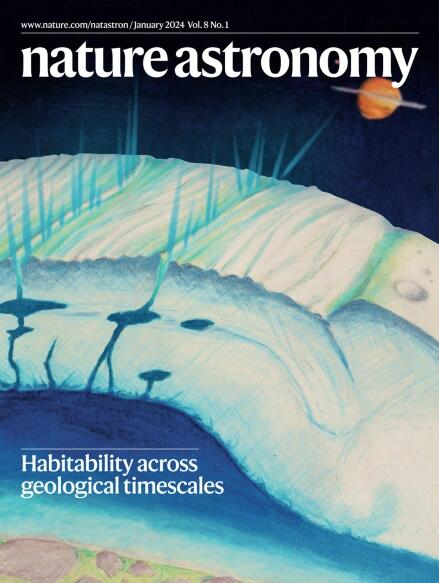在未来十年的x射线天文学背景下的新瓦瑟纳任务概念
IF 12.9
1区 物理与天体物理
Q1 ASTRONOMY & ASTROPHYSICS
引用次数: 0
摘要
钱德拉和xmm -牛顿等大型x射线天文台在许多研究领域取得了科学突破,包括太阳系、恒星天体物理学、恒星爆炸和致密天体、吸积超大质量黑洞,以及通过热等离子体渗透和周围星系群和星团追踪的大尺度结构。最近发射的x射线成像和光谱学任务天文台正式开启了非色散高分辨率光谱学的新观测窗口。然而,仍有几个问题有待解决,例如恒星辐射场对附近行星宜居性的影响、中子星中调节物质的状态方程、宇宙中金属的起源和分布、被暗物质引力势锁定的重子的宇宙学演化过程、超大质量黑洞生长对星系演化的影响等,仅举几例。此外,x射线天文学在多信使天体物理学中起着关键作用。通过实验解决这些问题,需要在灵敏度、光谱学和测量能力方面比现有的x射线天文台有一个数量级的飞跃。本文简要总结了高能天体物理学有望在未来十年为我们对宇宙的理解做出贡献的主要领域,并描述了欧洲航天局、全世界科学界和两个国际合作伙伴(JAXA和NASA)正在研究的一个新的任务概念,旨在实现变革性的发现:NewAthena。这一概念继承了之前直到2022年进行的雅典娜研究的基本有效载荷设计。本文章由计算机程序翻译,如有差异,请以英文原文为准。


The NewAthena mission concept in the context of the next decade of X-ray astronomy
Large X-ray observatories such as Chandra and XMM-Newton have been delivering scientific breakthroughs in research fields as diverse as our Solar System, the astrophysics of stars, stellar explosions and compact objects, accreting supermassive black holes, and large-scale structures traced by the hot plasma permeating and surrounding galaxy groups and clusters. The recently launched X-Ray Imaging and Spectroscopy Mission observatory is opening in earnest the new observational window of non-dispersive high-resolution spectroscopy. However, several questions remain open, such as the effect of the stellar radiation field on the habitability of nearby planets, the equation of state regulating matter in neutron stars, the origin and distribution of metals in the Universe, the processes driving the cosmological evolution of the baryons locked in the gravitational potential of dark matter and the impact of supermassive black hole growth on galaxy evolution, to mention just a few. Furthermore, X-ray astronomy has a key part to play in multimessenger astrophysics. Addressing these questions experimentally requires an order-of-magnitude leap in sensitivity, spectroscopy and survey capabilities with respect to existing X-ray observatories. This article succinctly summarizes the main areas where high-energy astrophysics is expected to contribute to our understanding of the Universe in the next decade and describes a new mission concept under study by the European Space Agency, the scientific community worldwide and two international partners (JAXA and NASA), designed to enable transformational discoveries: NewAthena. This concept inherits its basic payload design from a previous study carried out until 2022, Athena. This Perspective looks forwards to the next decade of X-ray astronomy, explaining how it will contribute to better understanding of the high-energy Universe. In this context, the authors describe the NewAthena mission, a concept led by the European Space Agency.
求助全文
通过发布文献求助,成功后即可免费获取论文全文。
去求助
来源期刊

Nature Astronomy
Physics and Astronomy-Astronomy and Astrophysics
CiteScore
19.50
自引率
2.80%
发文量
252
期刊介绍:
Nature Astronomy, the oldest science, has played a significant role in the history of Nature. Throughout the years, pioneering discoveries such as the first quasar, exoplanet, and understanding of spiral nebulae have been reported in the journal. With the introduction of Nature Astronomy, the field now receives expanded coverage, welcoming research in astronomy, astrophysics, and planetary science. The primary objective is to encourage closer collaboration among researchers in these related areas.
Similar to other journals under the Nature brand, Nature Astronomy boasts a devoted team of professional editors, ensuring fairness and rigorous peer-review processes. The journal maintains high standards in copy-editing and production, ensuring timely publication and editorial independence.
In addition to original research, Nature Astronomy publishes a wide range of content, including Comments, Reviews, News and Views, Features, and Correspondence. This diverse collection covers various disciplines within astronomy and includes contributions from a diverse range of voices.
 求助内容:
求助内容: 应助结果提醒方式:
应助结果提醒方式:


